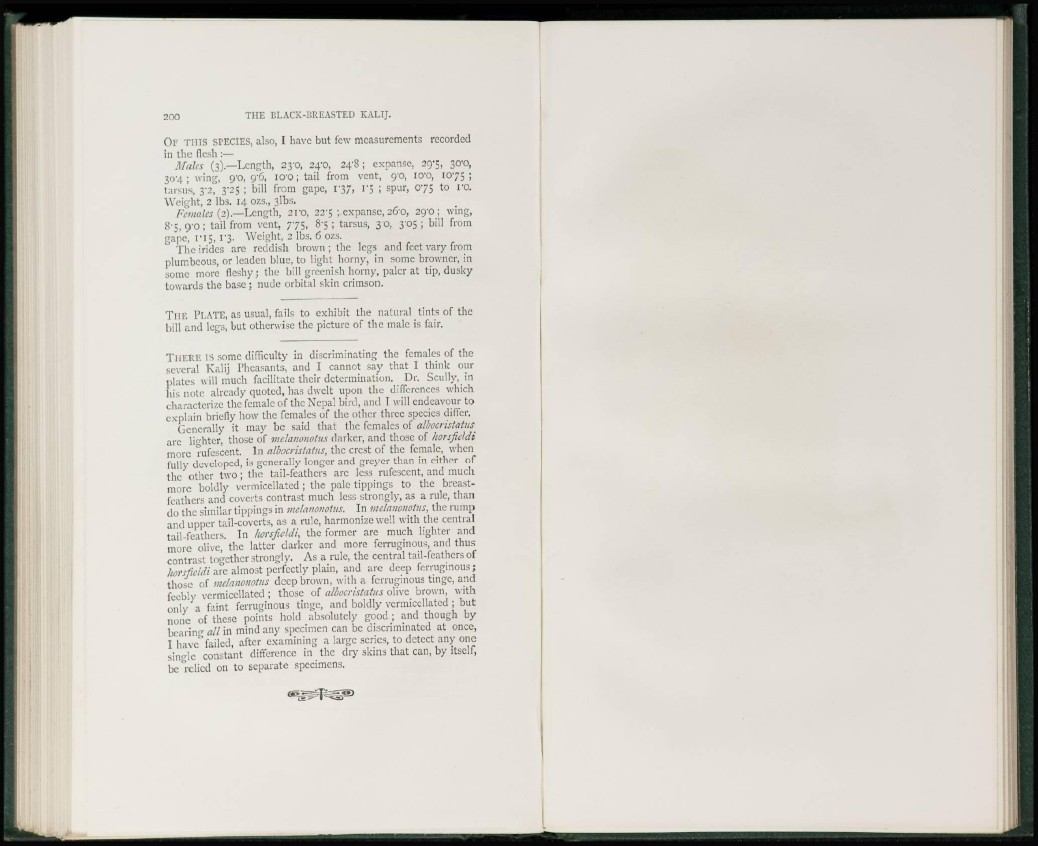
OE TUTS srEClES, also, I have but few measurements recorded
in the flesh :—
Males (3).—Length, 23'0, 24/0, 24/S ; expanse, 29-5, 30-0,
304 ; wing, 90, 9'6, 100; tail from vent, 90, IO'O, 1075 ;
tarsus, 3'2, 3'25 ; bill from gape, i'37, r$ ; spur, 075 to ro.
Weight, 2 lbs. 14 ozs., 3lbs.
Females (2).—Length, 2ro, 22'5 ; expanse, 26'0, 290; wing,
8-5, 9'0 ; tail from vent, 775, 8'5 ; tarsus, 30, 305 ; bill from
gape, I' I 5 , 1*3. Weight, 2 lbs. 6 ozs.
The irides arc reddish brown ; the legs and feet vary from
plumbeous, or leaden blue, to light horny, in some browner, in
some more fleshy; the bill greenish horny, paler at tip, dusky
towards the base ; nude orbital skin crimson.
T H E PLATE, as usual, fails to exhibit the natural tints of the
bill and legs, but otherwise the picture of the male is fair.
THERE IS some difficulty in discriminating the females of the
several Kalij Pheasants, and I cannot say that I think our
plates will much facilitate their determination. Dr. Scully, in
his note already quoted, has dwelt upon the differences which
characterize the female of the Nepal bird, and I will endeavour to
explain briefly how the females of the other three species differ.
Generally it may be said that the females of albocristatns
are lighter, those of melanonotus darker, and those of horsfieldi
more rufescent. In albocristatus, the crest of the female, when
fully developed, is generally longer and greyer than in either of
the other two ; the tail-feathers arc less rufescent, and much
more boldly vermiccllated ; the pale tippings to the breastfeathers
and coverts contrast much less strongly, as a rule, than
do the similar tippings in melanonotus. In melanonotus, the rump
and upper tail-coverts, as a rule, harmonize well with the central
tail-feathers. In horsfieldi, the former are much lighter and
more olive, the latter darker and more ferruginous, and thus
contrast together strongly. As a rule, the central tail-feathers of
horsfieldi are almost perfectly plain, and are deep ferruginous;
those of melanonotus deep brown, with a ferruginous tinge, and
feebly vermiccllated ; those of albocristatus olive brown, with
only a faint ferruginous tinge, and boldly vermiccllated ; but
none of these points hold absolutely good ; and though by
bearing all in mind any specimen can be discriminated at once,
I have failed, after examining a large series, to detect any one
single constant difference in the dry skins that can, by itself,
be relied on to separate specimens.